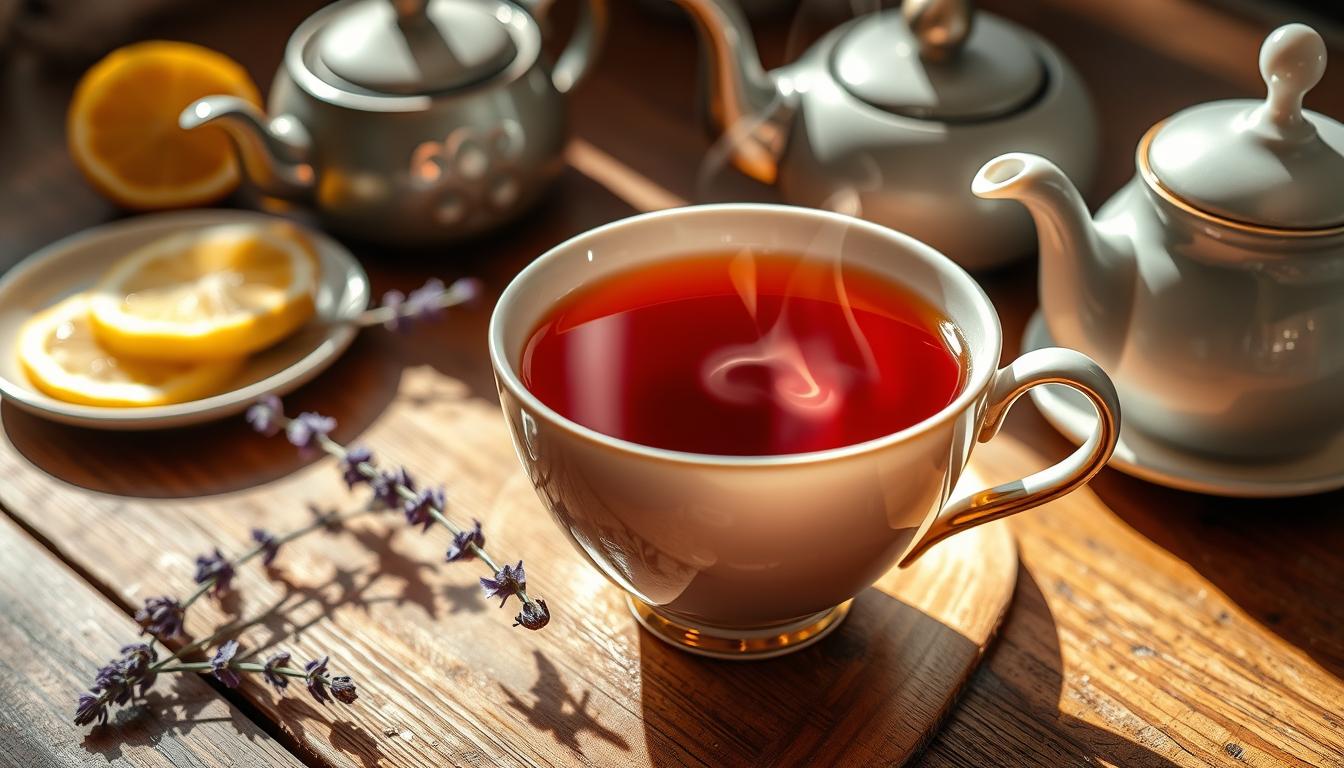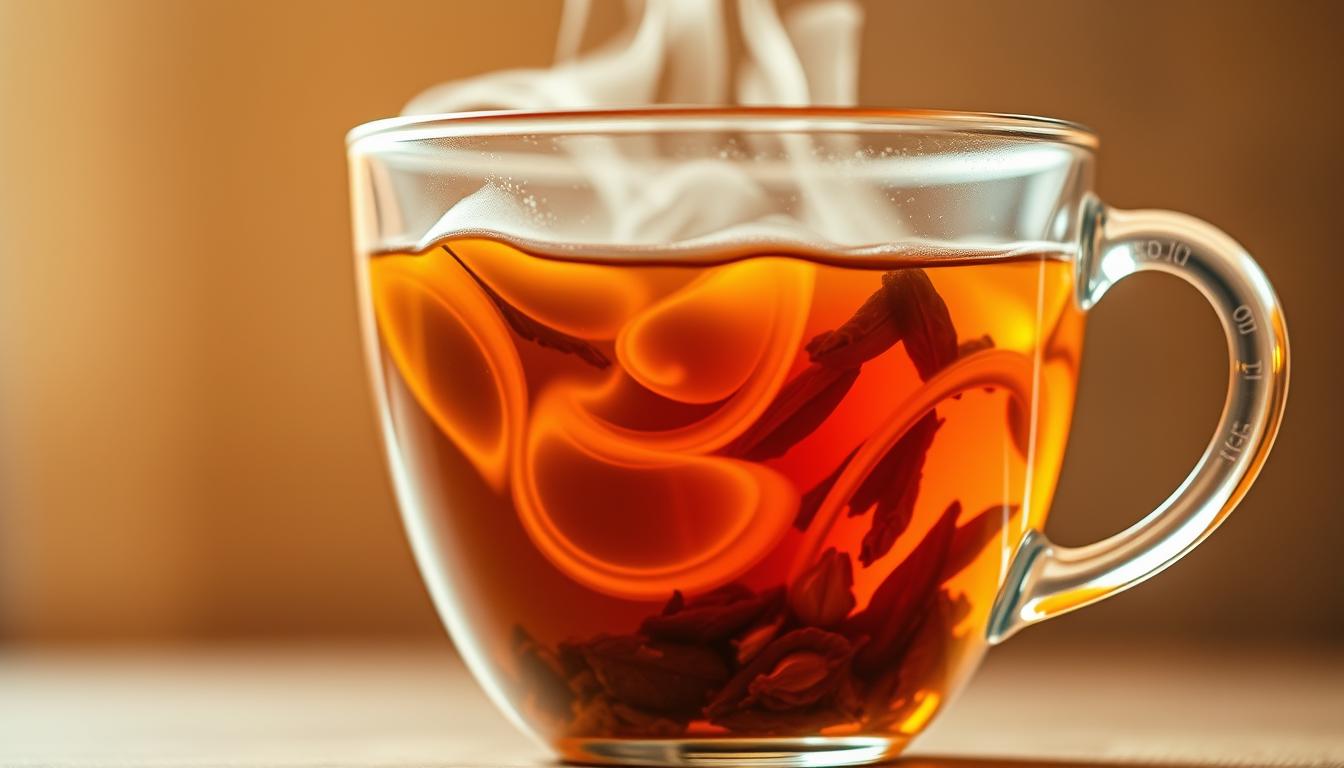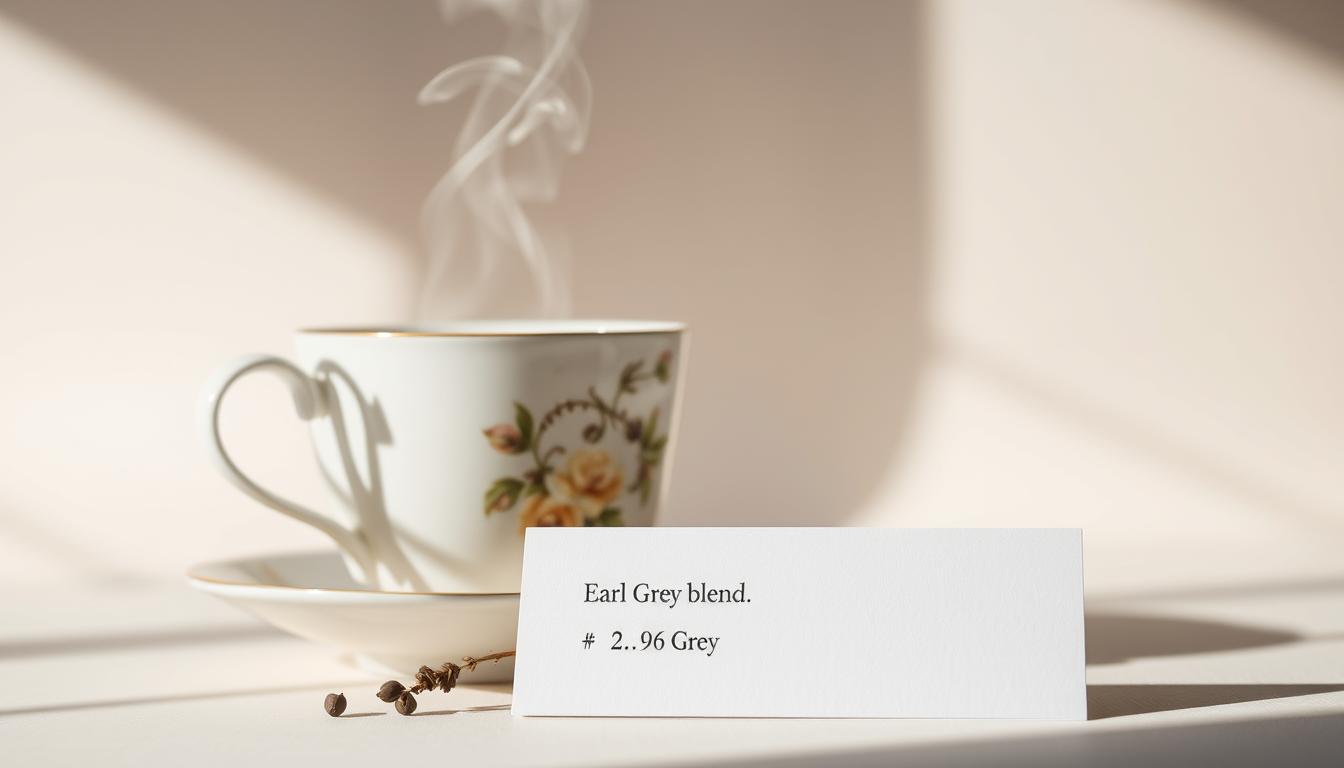Did you know that a single cup of Earl Grey tea contains about 85 milligrams of caffeine? This makes it a popular choice for those seeking a moderate energy boost. Earl Grey is a unique blend of black tea infused with bergamot oil, giving it a distinctive citrusy flavor.
The caffeine in Earl Grey comes from the Camellia sinensis plant, the same source as other true teas. Factors like brew time, water temperature, and the quality of the tea leaves can influence the caffeine content. Understanding these elements can help you tailor your tea experience to your preferences.
In this article, we’ll explore the caffeine levels in Earl Grey, compare it to other beverages, and discuss its potential health benefits. Whether you’re a tea enthusiast or just curious, this guide will provide valuable insights.
Key Takeaways
- Earl Grey tea contains about 85 milligrams of caffeine per cup.
- It is a black tea infused with bergamot oil for a citrusy flavor.
- Caffeine in tea comes from the Camellia sinensis plant.
- Brew time, water temperature, and tea quality affect caffeine levels.
- Earl Grey offers a moderate caffeine boost compared to coffee.
Introduction to Earl Grey Tea
Known for its citrusy aroma, Earl Grey tea has become a favorite worldwide. This classic beverage combines black tea with bergamot oil, creating a unique flavor that sets it apart from other varieties. Its refreshing taste and rich history make it a staple in tea culture.

What is Earl Grey Tea?
Earl Grey tea is a blend of black tea infused with bergamot oil. The addition of bergamot gives it a distinctive citrusy and floral aroma. Unlike regular black tea, this infusion adds a layer of complexity to the flavor, making it a refined choice for tea enthusiasts.
History and Origins
The origins of Earl Grey tea trace back to England in the 19th century. It was initially created to mask the taste of lower-quality tea leaves. Over time, it evolved into a celebrated beverage, cherished for its unique flavor. Today, it’s enjoyed globally as a symbol of sophistication and tradition.
The flavor profile of Earl Grey is often described as citrusy, floral, and slightly vanilla-like. This combination makes it a versatile drink, perfect for any time of day. Whether you’re new to grey tea or a seasoned tea drinker, Earl Grey offers a delightful experience that connects you to the broader world of tea culture.
The Role of Bergamot Oil in Earl Grey
Bergamot oil is the secret behind Earl Grey’s iconic flavor. This essential oil, extracted from the rind of the bergamot orange, adds a citrusy aroma and taste that sets it apart from other teas. Its inclusion in the blend creates a unique sensory experience that tea lovers cherish.

Citrusy Aroma and Flavor Profile
The bergamot orange is a bitter citrus fruit native to Italy. Its oil is widely used in perfumes, candles, and, of course, tea. When blended with black tea, it imparts a refreshing citrus note that balances the robustness of the tea leaves. This combination results in a fragrant and flavorful infusion.
Bergamot oil doesn’t just add flavor; it enhances the overall profile of the tea. The citrusy aroma is uplifting, making it a perfect choice for a relaxing afternoon brew. Its natural oils create a smooth, well-rounded taste that appeals to both seasoned tea drinkers and newcomers.
Impact on the Tea’s Composition
While bergamot oil significantly influences the flavor, it doesn’t alter the caffeine content of the tea. Instead, it complements the natural properties of black tea, creating a harmonious blend. The oil’s light, floral notes add depth without overpowering the tea’s inherent characteristics.
Here’s a quick comparison of bergamot oil’s properties:
| Property | Description |
|---|---|
| Aroma | Citrusy, floral, and slightly sweet |
| Flavor | Bright and refreshing with a hint of bitterness |
| Impact on Tea | Enhances flavor without affecting caffeine levels |
Bergamot oil’s role in Earl Grey is undeniable. It transforms a simple black tea into a sophisticated and aromatic beverage. Whether you’re sipping it for its flavor or its calming effects, this blend offers a truly unique tea experience.
How much caffeine is in earl grey tea: Exploring the Numbers
Understanding the caffeine levels in Earl Grey can help you make informed choices about your daily brew. A typical 230ml cup contains around 85 milligrams of this stimulant, but this number isn’t set in stone. Several factors can influence the final amount caffeine in your drink.
Average Caffeine Content in a Cup
On average, a cup of Earl Grey holds about 85 milligrams of caffeine. This amount provides a moderate energy boost, making it a popular choice for tea drinkers. However, the exact amount can vary based on several variables.
Factors Influencing Caffeine Levels
The tea leave quality plays a significant role in determining caffeine content. Higher-quality leaves often contain more of this stimulant. The water temperature and steeping time also affect the final result. Hotter water and longer steeping times extract more caffeine.
Using tea bags versus loose-leaf tea can also alter the concentration. Loose-leaf varieties tend to offer a more robust flavor and slightly higher caffeine levels. Natural variations, such as harvest time and varietal differences, further complicate the equation.
“The exact amount caffeine in Earl Grey is challenging to pinpoint due to these multiple variables.”
In summary, while 85 milligrams is a good estimate, the actual amount can vary. Understanding these factors allows you to tailor your brew to your preferences, ensuring a perfect cup every time.
Comparing Earl Grey with Other Caffeinated Beverages
Earl Grey stands out among caffeinated beverages for its unique flavor and moderate energy lift. While it’s a popular choice for tea enthusiasts, it’s worth exploring how it compares to other drinks like coffee and different tea varieties.
Earl Grey vs. Coffee
When it comes to caffeine, Earl Grey offers a gentler alternative to coffee. A standard cup of Earl Grey contains about 85 milligrams, while a cup of filter coffee packs around 140 milligrams. This makes coffee nearly twice as potent in terms of caffeine content.
For those seeking a milder boost, Earl Grey is an excellent choice. Its lower caffeine levels provide energy without the jitters often associated with coffee. Additionally, the citrusy notes of bergamot add a refreshing twist that coffee lacks.
Comparisons with Other Tea Varieties
Earl Grey’s caffeine content also varies when compared to other tea types. For instance, green tea typically contains 20-45 milligrams per cup, while herbal teas are usually caffeine-free. Even among black tea varieties, Earl Grey’s caffeine levels can differ based on processing and steeping methods.
Here’s a quick breakdown of caffeine levels in popular tea varieties:
- Black tea: 40-70 milligrams per cup
- Green tea: 20-45 milligrams per cup
- Herbal tea: 0 milligrams
Steeping time and water temperature also play a role. Longer steeping and hotter water extract more caffeine, regardless of the tea variety. This means even two cups of Earl Grey can have slightly different caffeine levels depending on how they’re brewed.
“The exact caffeine content in Earl Grey can vary, but it consistently offers a balanced option for tea drinkers.”
In summary, while Earl Grey provides a moderate caffeine boost, it’s essential to consider individual preferences and tolerance. Whether you prefer it over coffee or other tea varieties, Earl Grey’s unique flavor and versatility make it a standout choice.
Health Implications and Benefits of Earl Grey Tea
Earl Grey tea offers more than just a delightful flavor—it’s packed with potential health perks. From boosting brain function to supporting heart health, this classic beverage has much to offer. Let’s explore how it can positively impact your well-being.
Cognitive and Mood Benefits
The benefit of Earl Grey extends to your mind. Studies suggest that moderate consumption can improve cognitive function and reduce the risk of depression. The combination of caffeine and antioxidants in the Camellia sinensis plant helps enhance focus and elevate mood.
For many drinkers, this makes it an ideal choice for starting the day or overcoming an afternoon slump. The uplifting citrus notes from bergamot oil add an extra layer of mental clarity.
Antioxidants, Heart Health, and Cholesterol
Earl Grey is rich in antioxidants, which play a key role in protecting your body from oxidative stress. These compounds, particularly polyphenols, may help lower LDL cholesterol levels. This supports better heart health and reduces the risk of cardiovascular issues.
Compared to green tea, Earl Grey offers a unique blend of benefits thanks to its bergamot infusion. While both are derived from the Camellia sinensis plant, the added citrus oils in Earl Grey provide an extra edge.
Potential Downsides with High Consumption
While moderate consumption is generally safe for most drinkers, excessive intake can lead to issues like increased anxiety or electrolyte imbalances. Drinking 4-6 cups a day is considered safe for the average person.
For those sensitive to caffeine, opting for herbal tea or decaffeinated options might be a better choice. Always listen to your body and adjust your intake accordingly.
In summary, Earl Grey tea is more than a flavorful beverage—it’s a source of numerous health benefits. Whether you enjoy it for its mental boost or heart-healthy properties, it’s a versatile addition to your daily routine.
Tips for Brewing the Perfect Cup of Earl Grey Tea
Brewing the perfect cup of Earl Grey requires attention to detail and the right techniques. Whether you’re a seasoned tea drinker or a beginner, these tips will help you unlock the full flavor of this classic beverage.
Optimal Water Temperature and Steep Time
For the best results, use water at or near boiling (around 200°F). This temperature ensures proper extraction of flavors without scalding the leaves. Steep your tea for three to four minutes to balance taste and avoid bitterness.
Shorter steeping time may result in a weaker brew, while longer periods can make it overly strong. Experiment to find your preferred strength, but stick to the recommended range for consistency.
Loose-Leaf Versus Tea Bags
Loose-leaf tea offers a more nuanced flavor compared to tea bags. The larger leaves allow for better infusion, resulting in a richer taste. Tea bags, on the other hand, often contain crushed leaves that release flavor and caffeine more quickly.
Here’s a quick comparison of the two options:
| Type | Flavor | Convenience |
|---|---|---|
| Loose-Leaf | Rich and nuanced | Requires a strainer or infuser |
| Tea Bags | Quick and consistent | Easy to use, portable |
Using high-quality tea leaves is essential to avoid bitter notes. Whether you choose loose-leaf or tea bags, ensure the leaves are fresh and well-stored for the best results.
For those who enjoy experimenting, try adjusting the water temperature or steeping time to suit your taste. Earl Grey’s versatility makes it a delightful variety to explore in your daily routine.
Conclusion
Earl Grey tea is a timeless classic, offering a harmonious blend of flavor and energy. With its moderate caffeine levels, it provides a gentle boost compared to coffee. The addition of bergamot oil creates a unique citrusy aroma that sets it apart from other black tea varieties.
This beloved tea is not just about taste—it’s packed with antioxidants and cognitive benefits. Whether you prefer loose-leaf or tea bags, experimenting with brewing time and water temperature can enhance your experience.
For those seeking variety, green tea and herbal tea are excellent complementary options. Ultimately, Earl Grey remains a refined choice for tea enthusiasts, balancing tradition and innovation in every cup.

